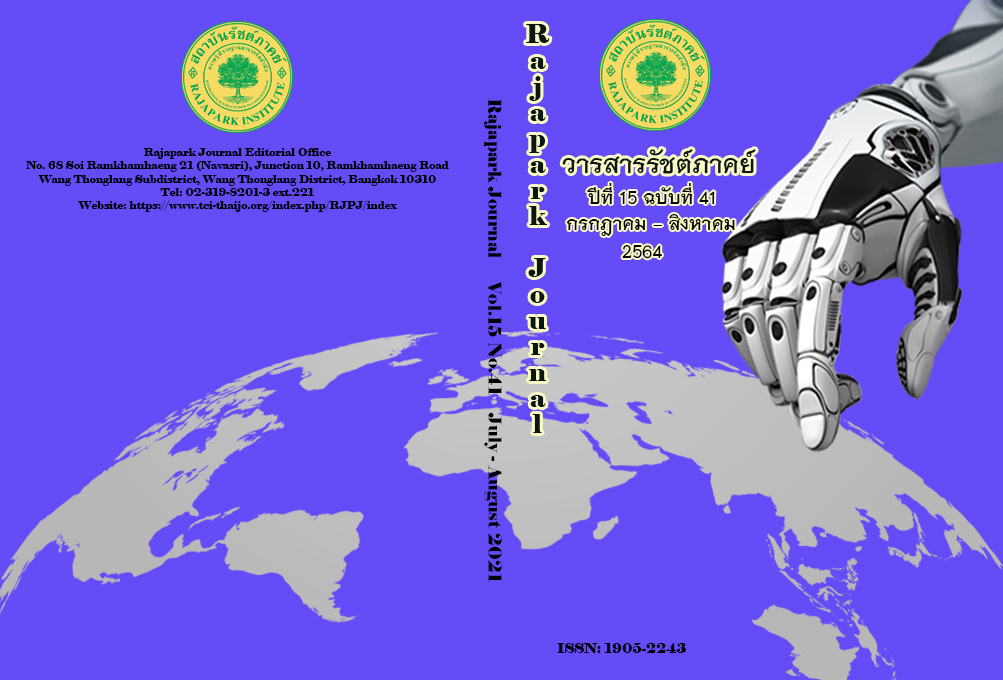An Analysis of Selectivity and Market Timing Ability of Equity Mutual Fund in Thailand
Main Article Content
Abstract
The equity mutual fund is crucially affected by volatility from the price change of securities invested. Therefore, mutual fund performance mainly depends on both security selectivity and market timing abilities. In this research, we focused on the analysis of the selectivity and market timing of equity mutual fund in Thailand. The set of sampling data came from 274 equity mutual funds, which reach out 5 years or more maturity date at the end of 2020. From January 2016 to December 2020, rate of return was measured by the change of the net asset value plus dividend. Moreover, the market index, the risk-fee return rate, and market systematic risk were measured through the SET TRI Index, 1-year treasury yield, and beta, respectively. Based on the work of Treynor & Mazuy (1966), we construct the statistical model, known by Panel Regression Data, in order to measure the selectivity and market timing abilities of the equity mutual fund is statistically significantly worse than that of the market index. However, the market timing ability of the fund gives better performance. The results were deeply investigated by fractioning into three-year time intervals as 2016-2018, 2017-2019, and 2018-2020. The second and third intervals draw the same conclusion as the overall five-year period, while the first interval shows the opposite remark. These may be caused by the situation differently. The Stock Exchange of Thailand has been in a downtrend during 2016-2017. In summary, the results suggest that in order to enhance the performance of equity mutual fund, the ability of selectivity should be improved efficiency of operation.
Article Details
Views and opinions appearing in the Journal it is the responsibility of the author of the article, and does not constitute the view and responsibility of the editorial team.
References
Association of Investment Management Companies. (2021). Ratio of Mutual Fund Accounts to Number of Deposit Accounts 1997-2019. Retrieved May 9, 2021, from http://oldweb.aimc.or.th/21_overview_detail.php?nid=9&subid=0&ntype=2
Bank of Thailand. (2021). Interest Rates in Financial Market (2005- present). Retrieved May 19, 2021, from https://www.bot.or.th/App/BTWS_STAT/statistics/BOTWEBSTAT.aspx? reportID=223&language=TH
Fama, E. (1972). Components of investment performance. The Journal of Finance, 27, 551-568.
Jenwittayaroje, N. (2017). The Performance and Its Persistence of Thailand Equity Mutual Funds from 1995 to 2014. Chulalongkorn Business Review, 39(152), 57-89.
Henriksson, R. D., & Merton, R. C. (1981). On Market Timing and Investment Performance II. Statistical Procedures for Evaluating Forecasting Skills. The Journal of Business, 54(4), 513-533.
Lonkani, R., Satjawathee, T., & Jegasothy, J. (2013). Selectivity and Market Timing Performance in a Developing Country’s Fund Industry: Thai Equity Funds Case. Journal of Applied Finance & Banking, 3(2), 89-108.
Markowitz, H. (1959), Portfolio Selection-Efficient Diversification of Investments. New York: Wiley.
Maroof, L., Aziz, S., & Basit, A. (2020). Relationship Between Fund Attributes and Timing Abilities: Empirical Evidence from Mutual Funds Industry of Pakistan. Forman Journal of Economic Studies, 16, 29-51.
Reilly, F. K., & Brown, C. (2012). Analysis of Investment and Management of Portfolio. (10th ed.). Canada: South-Western.
Sangkaew, J. (2002). Investment (5th ed.). Bangkok: Thammasat Printing House.
Satjawathee, T. (2014). Market Timing Performance. Suthiparithat Journal, 28(85), 22-44.
Sumeruwai, A., & Hensawang, S. (2004). Performance Evaluation of Equity and Fixed Income Mutual. Master of Business Administration. Kasetsart University.
The Stock Exchange of Thailand. (2005). Chapter 12 Mutual Funds and Investment Units. Retrieved May 19, 2021, from https://www.set.or.th/yfs/main/download/YFS2017_YFSCamp_FinPL_Reading02.pdf
Treynor, J., & Mazuy, K. (1966). Can Mutual Fund Outguess the Market?. Harvard Business Review, 44(4), 131-136.
www.thaibma.or.th. (n.d.). Government Bond Yield Curve. Retrieved March 19, 2021, from http://www.thaibma.or.th/EN/Market/YieldCurve/Government.aspx
www.thaimutualfund.com. (n.d.) Mutual fund data. Retrieved March 19, 2021, from https://www.thaimutualfund.com/AIMC/mutualFundCenter.jsp
www.wealthmagik.com. (n.d.). Fund Information. Retrieved March 19, 2021, from https://www.wealthmagik.com/FundInfo/FundHouseList.aspx


